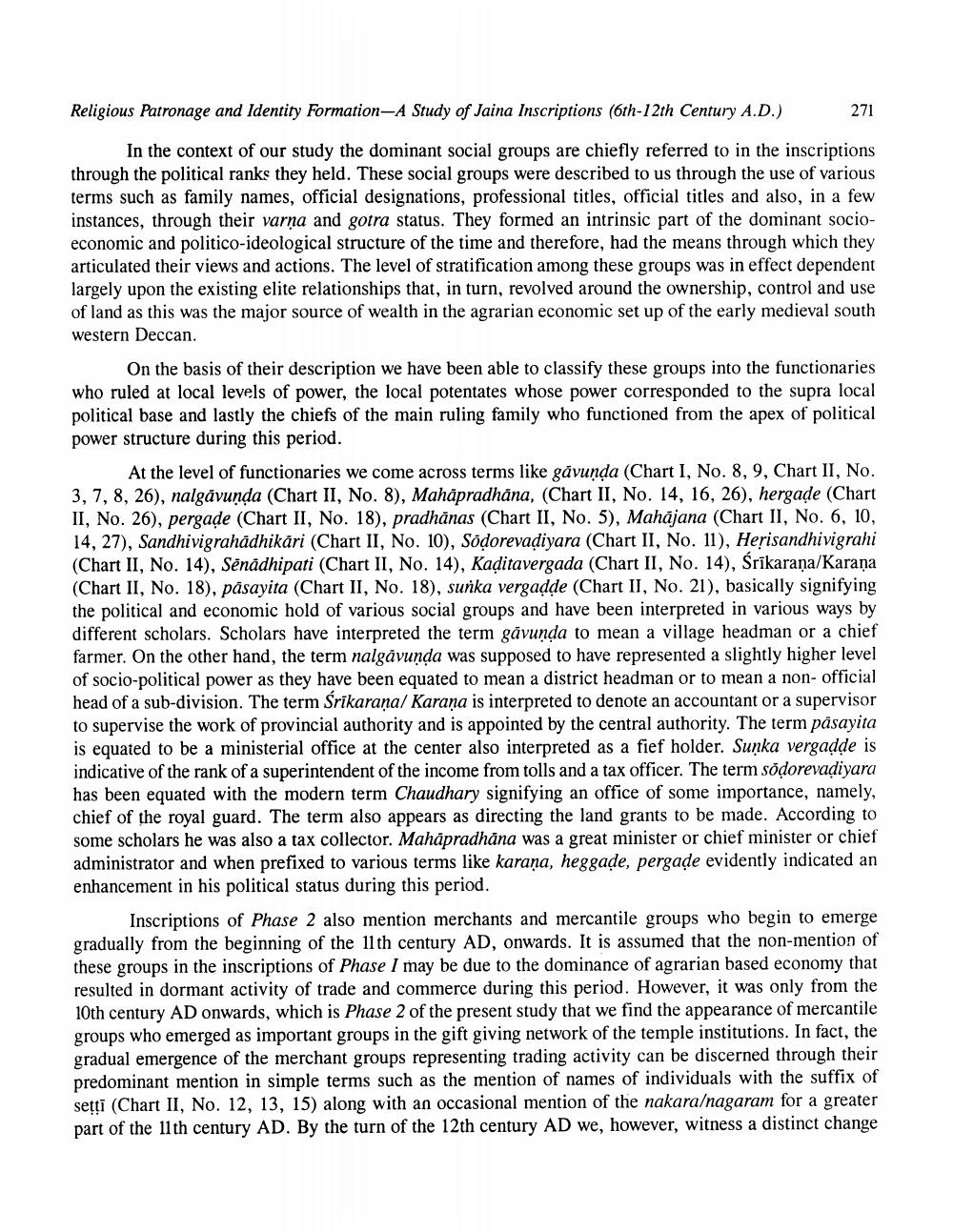________________
Religious Patronage and Identity Formation-A Study of Jaina Inscriptions (6th-12th Century A.D.)
In the context of our study the dominant social groups are chiefly referred to in the inscriptions through the political ranks they held. These social groups were described to us through the use of various terms such as family names, official designations, professional titles, official titles and also, in a few instances, through their varna and gotra status. They formed an intrinsic part of the dominant socioeconomic and politico-ideological structure of the time and therefore, had the means through which they articulated their views and actions. The level of stratification among these groups was in effect dependent largely upon the existing elite relationships that, in turn, revolved around the ownership, control and use of land as this was the major source of wealth in the agrarian economic set up of the early medieval south western Deccan.
271
On the basis of their description we have been able to classify these groups into the functionaries who ruled at local levels of power, the local potentates whose power corresponded to the supra local political base and lastly the chiefs of the main ruling family who functioned from the apex of political power structure during this period.
At the level of functionaries we come across terms like gavuṇḍa (Chart I, No. 8, 9, Chart II, No. 3, 7, 8, 26), nalgāvuṇḍa (Chart II, No. 8), Mahapradhana, (Chart II, No. 14, 16, 26), hergade (Chart II, No. 26), pergade (Chart II, No. 18), pradhanas (Chart II, No. 5), Mahajana (Chart II, No. 6, 10, 14, 27), Sandhivigrahadhikari (Chart II, No. 10), Sodorevadiyara (Chart II, No. 11). Heṛisandhivigrahi (Chart II, No. 14), Senddhipati (Chart II, No. 14), Kaditavergada (Chart II, No. 14), Srikarana/Karana (Chart II, No. 18), pasayita (Chart II, No. 18), sunka vergaḍde (Chart II, No. 21), basically signifying the political and economic hold of various social groups and have been interpreted in various ways by different scholars. Scholars have interpreted the term gāvuṇḍa to mean a village headman or a chief farmer. On the other hand, the term nalgavunda was supposed to have represented a slightly higher level of socio-political power as they have been equated to mean a district headman or to mean a non- official head of a sub-division. The term Śrīkaraṇa/ Karana is interpreted to denote an accountant or a supervisor to supervise the work of provincial authority and is appointed by the central authority. The term pasayita is equated to be a ministerial office at the center also interpreted as a fief holder. Sunka vergadde is indicative of the rank of a superintendent of the income from tolls and a tax officer. The term sodorevadiyara has been equated with the modern term Chaudhary signifying an office of some importance, namely, chief of the royal guard. The term also appears as directing the land grants to be made. According to some scholars he was also a tax collector. Mahapradhana was a great minister or chief minister or chief administrator and when prefixed to various terms like karana, heggade, pergade evidently indicated an enhancement in his political status during this period.
Inscriptions of Phase 2 also mention merchants and mercantile groups who begin to emerge gradually from the beginning of the 11th century AD, onwards. It is assumed that the non-mention of these groups in the inscriptions of Phase I may be due to the dominance of agrarian based economy that resulted in dormant activity of trade and commerce during this period. However, it was only from the 10th century AD onwards, which is Phase 2 of the present study that we find the appearance of mercantile groups who emerged as important groups in the gift giving network of the temple institutions. In fact, the gradual emergence of the merchant groups representing trading activity can be discerned through their predominant mention in simple terms such as the mention of names of individuals with the suffix of setti (Chart II, No. 12, 13, 15) along with an occasional mention of the nakara/nagaram for a greater part of the 11th century AD. By the turn of the 12th century AD we, however, witness a distinct change




